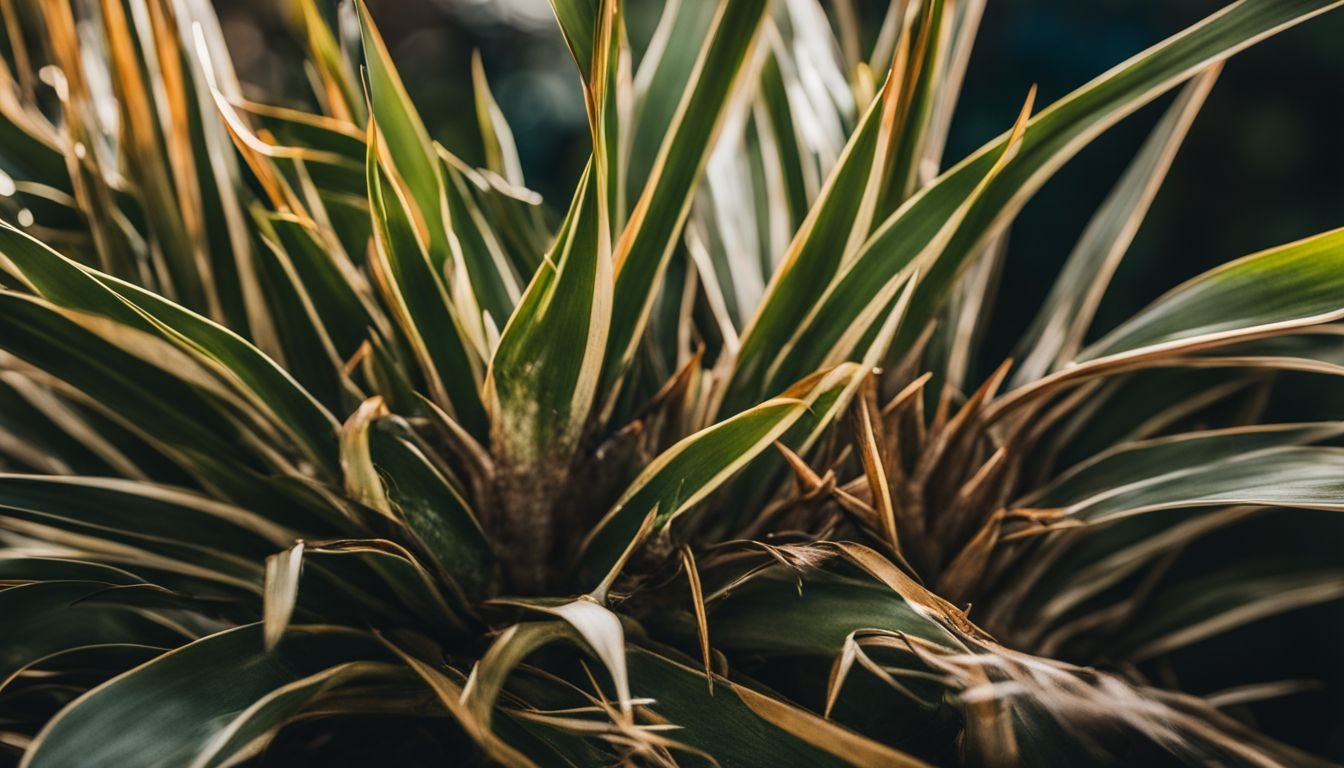Gardening enthusiasts often struggle to find the perfect drought-tolerant addition to their succulent collection. Enter the imposing Dragon Tree, a majestic plant native to the Canary Islands and revered for its resilience and unique appearance.
This guide will unveil tips and tricks for cultivating these evergreen wonders in your Australian home, ensuring you can enjoy their splendour with ease. Discover the Dragon Tree’s secrets!
Key Takeaways
- Dragon Trees need well – draining soil with perlite or coarse sand added, and they thrive both indoors and outdoors if the right conditions are met.
- The trees require little water once established, appreciating a light moistening of soil without being soggy to prevent root rot.
- Propagation of Dragon Trees can be done through seeds or cuttings in well – draining soil ensuring warmth and careful watering for growth.
- Mature Dragon Trees have a unique appearance with thick trunks and an umbrella – like canopy that adds prehistoric charm to gardens.
- While minimal care is needed, it’s important not to confuse Dragon Tree needs with those of the fruit-bearing cactus ‘Dragon Fruit Tree’; proper care includes occasional fertiliser application and possible pruning for shape.
Key Aspects of Dragon Tree Care

Cultivating the Dracaena draco, commonly known as the Dragon Tree, requires an understanding of its specific needs to thrive in Australian climates. From creating the perfect soil environment to mastering watering regimes, we’ll delve into how you can sustain this drought-tolerant species’ majestic presence in your garden.
Optimal Soil Conditions
Dragon Trees, known for their striking form and resilience, thrive in soil that demands little but one crucial characteristic: good drainage. These magnificent specimens adapt well to a range of soil types whether you’re planting in sandy coastal areas or the heavier soils found inland.
To create an ideal environment for your Dragon Tree, mix your potting medium with materials like perlite or coarse sand; this ensures excess water flows freely away from the roots, guarding against rot.
Ensure your plant’s home allows it to flourish by checking the pot or ground regularly for compacted soil – a common culprit that hampers drainage. For gardeners using containers, selecting pots with adequate holes at the base is key to healthy root development.
With these simple yet effective practices, maintaining optimal soil conditions becomes effortless, paving the way for your Dragon Tree to grow strong and elegant without unnecessary fuss over its foundation.
Watering Requirements
Understanding the watering needs of your dragon tree is crucial for its survival and thriving. If you have a majestic specimen planted directly in your Australian garden, rejoice at their drought tolerance; these trees generally do not require additional watering once established.
Their resilience allows them to adapt to arid conditions much like those found in their native Canary Islands homeland.
However, should you prefer the charm of an indoor dragon tree or one potted on your patio, a more attentive approach is necessary. Regularly check the potting mix and provide water to keep it lightly moist but never soggy—overwatering can spell disaster for these succulent-like trees.
During springtime’s growth spurts, seeds require consistent moisture, while taller cuttings may need extra support with stakes. Careful handling ensures that these elegant trees continue to enhance homes and gardens across Australia with their exotic presence and striking form.
Propagation Techniques for Dragon Trees

Plant enthusiasts often seek effective ways to propagate Dragon Trees, enticing more greenery into their spaces. Here are some steps to successfully grow these majestic plants from scratch:
- Securing healthy seeds or cuttings is the first crucial step for propagation. You can obtain them from a mature Dragon Tree, ensuring they come from a robust parent plant.
- Sow the seeds directly in well – draining soil mixed with sand or grit to create the perfect growing medium; this combination mimics the Dragon Tree’s natural habitat.
- Maintain an even temperature between 18 – 21C for seed germination. Consistent warmth aids in sprouting, as cold fluctuations can hinder growth.
- Water gently to keep the soil slightly moist, but be wary of overwatering. Dragon Trees are drought tolerant, and excessive moisture can lead to root rot.
- Cuttings should be taken from healthy branches, cutting just below a node where the leaf meets the stalk. This is where new roots will form.
- Allow the cutting’s base to dry out for a day or two before planting; this helps prevent infection and encourages rooting.
- Plant cuttings in a mixture of perlite and peat moss. These materials provide great aeration and moisture retention for young roots.
- Use rooting hormone on cuttings to enhance root development. Dusting the base with this substance can significantly improve chances of success.
- Patience is key as it may take several weeks for seedlings and cuttings to show significant growth. Nurture them with consistent care and watchful eyes.
Understanding the Growth Pattern and Appearance of Dragon Trees
Dragon Trees showcase a unique growth pattern that starts with a single stem. Over time, they slowly branch out forming an umbrella-like canopy. The bark is smooth and gray when the tree is young; as it matures, the bark becomes more rugged and scaly.
This evergreen tree proudly exhibits long, sword-shaped leaves that sprout from the end of its growing branches, creating a dramatic visual impact in any Australian garden. Furthermore, these trees have a slow but prolonged growth rate which adds to their charm over years of cultivation.
The appearance of mature Dragon Trees can be quite striking due to their thick trunks topped with dense foliage crowns—often compared to something straight out of prehistoric times.
Canary Islands Dragon Tree (D. draco), one specific variety native to Macaronesia region including Tenerife – known for ‘El Drago Milenario’ at Icod de los Vinos – displays red sap known as dragon’s blood.
This resin has had historical significance for various populations including the Guanches who considered it magical. As your own dragon tree begins to flourish under the Australian sun or part shade, take pride in nurturing this ornamental beauty that stands as a natural symbol and carries centuries of lore within its branching form.
Now let’s delve into tips for maintaining your thriving Dragon Tree healthy and strong.
Tips for Maintaining a Healthy Dragon Tree
Discover essential strategies for keeping your Dragon Tree vibrant and robust, from debunking common care myths to expert advice on pruning—read on for a world of flourishing foliage.
Misconceptions and Care for the Dragon Fruit Tree (related to Dragon Trees)
Many people confuse the dragon fruit tree with the dragon tree, yet they are distinctly different species. The term ‘dragon’ tends to tie them together in minds, but while Dracaena draco is an ornamental tree famed for its striking form and longevity, the Dragon Fruit Tree or Pitaya actually belongs to various cactus species.
It’s crucial to discern between these two when discussing care and cultivation. For example, dragon trees prefer less frequent watering as they have evolved to survive in dry conditions unlike their succulent fruit-bearing cousins which demand more regular hydration.
Caring for a dragon tree involves minimal fuss with some vital practices ensuring a healthy life span that can stretch across centuries. Ensure it’s planted in well-draining soil; this helps prevent root rot – a common issue among gardeners unfamiliar with its preferences.
A controlled-release fertiliser every 6-8 months will nourish it adequately without overfeeding. Pruning isn’t usually necessary but can be done carefully if desired to maintain shape or remove damaged leaves.
Unlike many plants that enjoy full sun, the dragon tree thrives under partial shade too, making it versatile for different garden spaces and enhancing landscapes with its unique silhouette symbolising resilience and natural beauty.
Conclusion: Enjoying the Unique Beauty of Dragon Trees
Caring for Dragon Trees adds a touch of exotic grandeur to any Australian garden or home. These sturdy plants offer an intriguing silhouette and a rich history, tied deeply to their origins in the Canary Islands.
Take pride in nurturing this ancient species, knowing it thrives under your watchful eye. Embrace the simple pleasures of growing such majestic flora right here down under. Let every glance at your thriving Dragon Tree remind you of nature’s enduring wonders and your own green thumb success.
FAQs
1. What makes the Dragon Tree a special plant to grow in Australia?
The Dragon Tree, particularly species like Dracaena draco and Dracaena cinnabari, is unique because it’s a natural symbol of Tenerife and has relatives that come from regions such as Cape Verde and Western Morocco. Its striking form and flower spike make it an eye-catching houseplant for Australian succulent lovers.
2. How do I care for my Dragon Tree to ensure it thrives?
To keep your Dragon Tree healthy, provide well-draining soil, place it in bright indirect light, water when the topsoil feels dry, and avoid overwatering to prevent root rot – essential tips for any succulent aficionado.
3. Can I pay for my Dragon Tree with digital methods like Apple Pay or PayPal?
Yes, many nurseries now accept modern payment methods including Visa, MasterCard, American Express, Apple Pay, and PayPal – making buying this captivating monocotyledon convenient.
4. Where can I see mature Dragon Trees in their natural habitat?
If you’re seeking inspiration or want to admire mature specimens of the mystical Dracaena draco species such as Dracaena tamaranae from La Palma or visit landmarks like Parque del Drago in Islas Canarias where these trees are celebrated.
5. Does the sap of all varieties of Dragon Trees have unique properties?
Indeed! Known as “dragon’s blood,” the sap found across different types boasts distinctive traits; Asparagus Draco will produce red resin historically valued for its presumed medicinal qualities.
